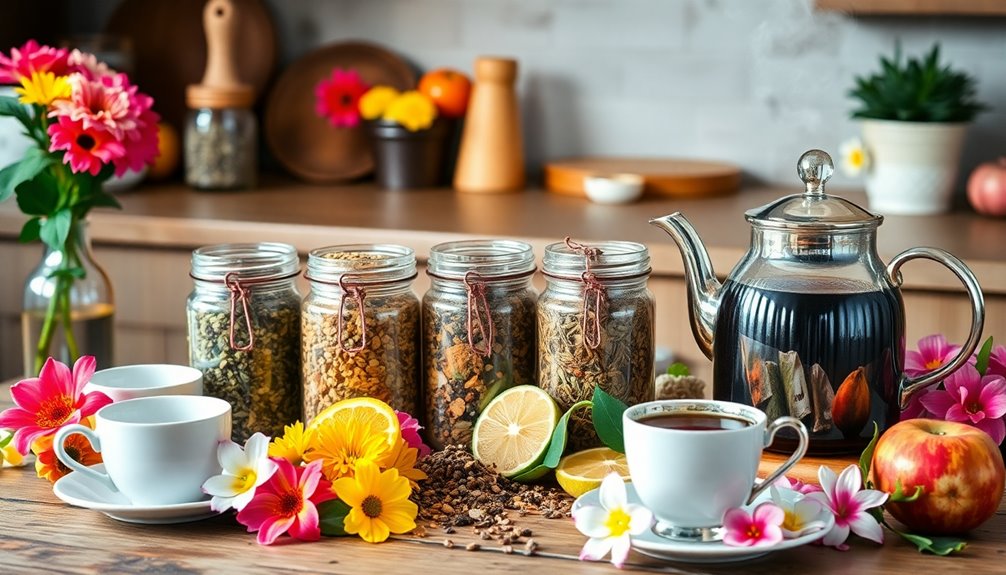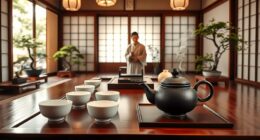To create vibrant homemade tea blends with herbs and fruit, start by choosing fresh or dried ingredients like mint, chamomile, berries, and citrus zest. Combine these in your teapot or infuser, experimenting with flavors and textures, then steep for 5-10 minutes. Adjust the steeping time and ingredient ratios to suit your taste and wellness goals. Keep exploring different combinations and techniques, and you’ll uncover exciting new blends to enjoy and share.
Key Takeaways
- Combine dried herbs like chamomile and mint with fresh fruit such as berries for vibrant, flavorful blends.
- Experiment with spices like cinnamon or ginger to add warmth and depth to herbal and fruity teas.
- Adjust steeping times based on ingredient delicacy to optimize flavor extraction and aroma.
- Personalize blends to target wellness goals like relaxation, digestion, or immunity support.
- Share your unique creations with friends, turning tea-making into a creative and healthful ritual.

Creating your own tea blends at home offers a fun and rewarding way to customize flavors and enhance your tea-drinking experience. When you start experimenting with herbs and fruits, you discover a world of unique tastes and health benefits. One of the most exciting aspects is how you can craft tea infusions that not only taste great but also serve as herbal remedies. By selecting specific herbs, you can target wellness goals like relaxation, digestion, or boosting immunity. For example, adding chamomile and lavender creates a calming tea infusion that helps you unwind after a busy day, while ginger and lemon can energize and support your immune system.
To begin, gather fresh or dried herbs and fruits that appeal to your palate. Dried herbs like peppermint, chamomile, or lemongrass work well because they release their flavors slowly and consistently. Fresh herbs, such as mint or basil, can also be used, but they might require a slightly different brewing method. When creating your herbal tea infusion, it’s important to weigh the balance of flavors. Combining sweet fruits like berries or apple slices with tart herbs like hibiscus or lemon zest can produce a vibrant, invigorating blend. You can also experiment with spices like cinnamon or cloves to add warmth and depth.
Brewing your custom tea blends is straightforward. Simply add your herbs and fruit to a teapot or infuser, pour hot water over them, and let steep. The steeping time influences the strength of your flavor, so adjust accordingly—usually around 5 to 10 minutes. As you become more experienced, you’ll learn how different combinations release their flavors and how to tweak steeping times for ideal taste. Keep in mind that some herbs, like ginger, can be added directly into boiling water, while delicate flowers or leaves are better suited for shorter steep times.
Making your own herbal remedies through tea infusion is both practical and enjoyable. You can create blends that promote relaxation, aid digestion, or energize your mornings. Customization allows you to avoid artificial flavors and preservatives, opting instead for natural, wholesome ingredients. Plus, sharing your homemade blends with friends adds a personal touch to gatherings. As you explore different herbs and fruits, you’ll discover which combinations best suit your health needs and taste preferences. Incorporating knowledge about Cultural Intelligence can also help you appreciate the cultural origins and traditional uses of various herbs, enriching your experience and understanding. Creating your own tea blends is a wonderful way to turn everyday tea time into a personalized wellness ritual, combining flavor, health, and creativity in every cup.
Frequently Asked Questions
How Long Do Homemade Herbal Tea Blends Stay Fresh?
Your homemade herbal tea blends typically stay fresh for about 6 to 12 months, depending on storage. To maximize tea shelf life and herbal freshness, keep your blends in airtight containers, away from sunlight and moisture. Proper storage helps preserve flavor and potency. Check for any signs of mold or loss of aroma before brewing. With good storage, your homemade herbal teas remain flavorful and aromatic for a long time.
Can I Use Dried Herbs and Fruits Interchangeably?
You can’t always use dried herbs and fruits interchangeably because herb potency and flavor preservation differ. Dried herbs tend to have concentrated flavors, making them more potent, while dried fruits offer a sweeter, subtler taste. When swapping, consider these differences to maintain balance. Using fresh ingredients might be better for vibrant flavor, but dried options are convenient. Adjust quantities accordingly to guarantee your tea blend remains flavorful and aromatic.
Are There Any Health Benefits Specific to Certain Herbs?
Yes, certain herbs offer specific medicinal herbal benefits and are known for their herbal antioxidant properties. For example, chamomile can help reduce stress and improve sleep, while peppermint aids digestion. Incorporating herbs like ginger boosts immunity, and turmeric offers anti-inflammatory effects. By choosing herbs with known health benefits, you can enhance your tea’s medicinal value and support your overall wellness naturally.
What’s the Best Storage Method for Homemade Tea Blends?
Imagine placing your treasured tea blend in a cozy, airtight container, like a gentle hug that keeps freshness intact. Store it in a cool, dark place, away from sunlight and humidity, to preserve its vibrant flavors. This method prevents air, light, and moisture from stealing its essence, ensuring every cup you brew is as delightful as when you first created it. Keep your blends fresh and flavorful with this simple storage secret.
How Do I Adjust Sweetness in Herbal Tea Infusions?
To adjust sweetness in herbal tea infusions, focus on balancing flavors by adding natural sweetener options like honey, agave syrup, or stevia. Start with small amounts and taste as you go to find the perfect level. You can also enhance sweetness by using naturally sweet herbs or fruits, which complement the blend and reduce the need for added sweeteners. This way, you keep your tea flavorful and satisfying without overdoing it.
Conclusion
So, next time you think store-bought tea is enough, remember all the vibrant herbs and fruits waiting in your kitchen. You’ve got the power to craft a delightful blend that’s both unique and invigorating—no fancy store needed. It’s amusing, really—you spend minutes mixing simple ingredients, yet end up with a brew that feels like a luxurious escape. Who knew that the best teas are just a few herbs and fruits away from turning your day around?










